An introduction programme for drivers of heavy motor vehicles
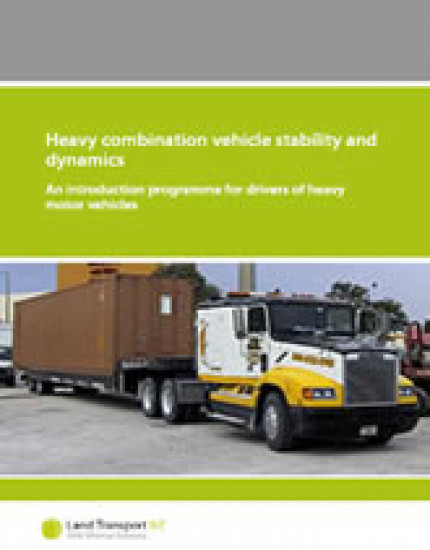
There are many factors influence a vehicle's tendency to roll over, but the following are the most crucial:
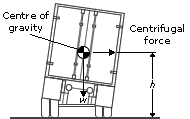
If all these factors are contained within acceptable levels, the vehicle will remain stable. If they are not, then the risk of loss of control and rollover will increase.
Typically rollovers occur during cornering (at either high or low speed) and sudden evasive steering manoeuvres.
The following is an example of how rollover can occur at a roundabout even though the truck may be proceeding straight through.
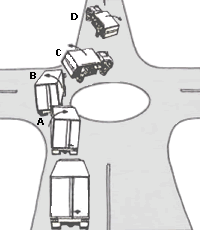
The driver of a loaded truck intends to proceed straight through a roundabout. He/she safely negotiates the left-hand bend at point ‘A’ and the vehicle rolls to the right. The driver then swings the steering to the right at ‘B’ to travel around the roundabout and the vehicle rolls to the left. But this time it rolls much further than it did at point ‘A’ because the directional changes of the vehicle match its roll resonance. At this point the load might even shift, transferring more weight to the left-hand side of the vehicle, increasing the roll still further and possibly overturning the vehicle on to its left side at point ‘C’ as shown. However, if the vehicle is able to continue past point ‘C’ and the driver then steers to the left, the vehicle will roll back to the right still more violently and is even more likely to overturn, this time on to its right side at point ‘D’.
This can occur at a surprisingly low speed, speeds which may be quite safe for another type of truck, even when fully laden. This danger is not restricted to roundabouts; S-bends and violent lane changes can present a similar hazard.
Drivers operating heavy vehicles need to make constant steering corrections, whether to compensate for simple road undulations and the effects of camber or wind, or when negotiating intersections and undertaking evasive manoeuvres to avoid other vehicles or obstacles.
These manoeuvres can be at relatively low speed but involve several directional changes (as in a roundabout) or take place at high speed, as in a steering correction during cornering or changing lanes. In each of these situations there is transfer of weight from one side of the vehicle to the other.
With a heavy combination vehicle the effect of changing direction at higher speeds raises a number of additional issues to those normally experienced when driving a rigid vehicle. One of the most significant of these is rearward amplification or ‘cracking the whip’.
This only applies to heavy combination vehicles where in the total length of the combination there is more than one articulation (pivot) point. For example, a truck and trailer combination has a pivot point in the draw bar coupling; a ‘B’ train has two pivot points, one in each turntable where the kingpin is locked into the turntable jaws.
Rearward amplification, or cracking the whip, occurs during a rapid lane change where a relatively small steering input of the towing vehicle is amplified (increased), through each pivot point. The result being that the end trailer in a combination can react very violently to the lane change.
Overseas research has demonstrated that cracking the whip becomes a significant stability factor at road speeds above 60 km/h.
Manoeuvring a combination vehicle, particularly at lower speeds, introduces a number of factors of greater significance than those encountered when manoeuvring a rigid vehicle.
As a general rule, the more manoeuvrable a combination vehicle is, the less stable it is likely to be in open road driving situations.
When a long vehicle makes a low-speed turn, at an intersection for example, the rear of the vehicle may off-track (take a different path) around the corner than the towing vehicle. In some situations there can be several metres difference.
This is shown in the picture below:
Drivers of heavy combination vehicles must be aware of this whenever they manoeuvre a vehicle, particularly when the result of offtracking could be for the vehicle to come into contact with another vehicle or a building.
When a heavy combination makes a turn, especially a sharp turn to the left or right, the trailer or trailers do not necessarily follow in the same path (track) of the towing vehicle. This is similar to off-tracking. Swept path is illustrated in the image below.
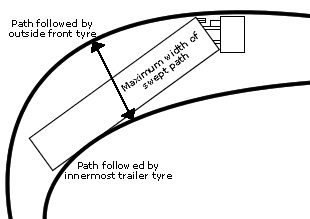
Associated with swept path is swing out. This is the effect that is caused by the rear of the trailer (its rear overhang) taking a path outside that of the rest of the vehicle. This is illustrated in the image below.
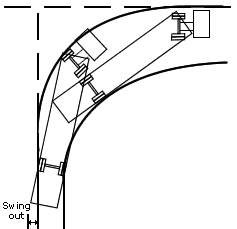
Any vehicle that is being towed by another vehicle will experience some degree of sway from side to side (yaw). The amount of yaw experienced by the towing vehicle is influenced by a number of factors, but speed and loading conditions are the most crucial factors. Yaw is generally explained as the way in which the trailer trails the towing vehicle.
Once a trailer has started to yaw (sway from side to side) it can quickly develop into an uncontrollable situation and can easily result in the vehicle overturning. A safe method of reducing trailer yaw is to slow down but do not use the brake as this could easily develop into a jack knife situation.
Trailer yaw should not be confused with rearward amplification. Trailer yaw is a swaying motion that can be encountered on straight roads and can develop without any steering input from the driver. Rearward amplification on the other hand is a result of a lane change or similar manoeuvre where the driver alters the path of the vehicle through the steering.